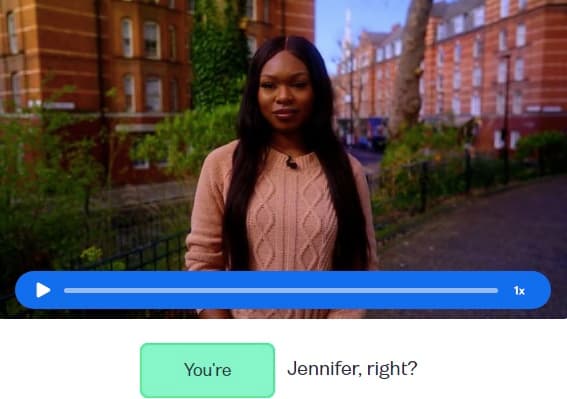I want to learn...
Author:

Barney Meekin
If you want to be a good communicator, you need to know how to keep conversations flowing, and that means using tag questions. Being a good communicator is more than just remembering words and grammar. You also need to show interest in the people you talk with. You need to keep them engaged with what you say. One of the easiest ways to do this is with tag questions.
Read on to learn how to use tag questions to keep your conversations going.
What are tag questions?
Tag questions are short questions you can add to the end of a sentence. Use them to engage your listeners, check understanding, ask for information or ask for confirmation. Here’s an example dialogue so you can see them in action:
Speaker A:That movie was great, wasn’t it?
Speaker B:It was interesting. But I didn’t understand all of it. The guy with the limp was the bad guy, was he?
Speaker A:Yes. It showed him walking without a limp at the end. He controlled everything. You didn’t fall asleep, did you?
Speaker B:No! I didn’t fall asleep. But if he was the real bad guy, why talk so much to the police? It doesn't make sense, does it?
Tag questions: Rules and exceptions
Here’s the basic rule for forming a tag question: If the main verb of the sentence is positive, the tag is negative, and if the main verb is negative, the tag is positive. Just remembering this will get you a long way with tag questions. Here are some examples:
"She is coming, isn't she?"
"They aren’t here, are they?"
Here are nine more rules or exceptions you should understand:
1. Auxiliary verbs
If your sentence includes auxiliary verbs (for example, ‘be,’ ‘do,’ ‘have’) or modal auxiliary verbs (for example, ‘can,’ ‘will,’ ‘should’), use the same verb in the question tag. Here are some examples:
"We are going to the party, aren't we?"
“You don’t live in London, do you?”
"You have finished the work, haven't you?"
"She can swim, can't she?"
“You will come, won’t you?”
“I probably shouldn’t eat this, should I?”
“She couldn’t hear me, could she?”
2. Other verbs
In sentences without an auxiliary verb, don’t repeat the main verb. Use ‘do’ instead.
"You like coffee, don't you?"
"He played the guitar, didn't he?"
“She used to be very sporty, didn’t she?”
“He always goes to bed early, doesn’t he?”
“The teacher told you, didn’t she?”
“They don’t live here, do they?”
“It doesn’t come from here, does it?”
3. ‘I am’
As with most things in English, there are some exceptions. I know I said use the same word in the question tag when you use the verb ‘to be.’ But that’s not always true. When you use ‘I am’ in the main sentence, use ‘aren’t I?’ as the question tag instead.
"I am early, aren't I?"
“I’m still young, aren't I?”
Weirdly, if you say ‘I am not’ in the main sentence, say “am I?” in the question tag. This follows the rules for auxiliary verbs that I explained earlier.
“I’m not going to do that, am I?”
“I’m not making any sense, am I?”
4. ‘Let’s’
When you use ‘let’s’ in your main sentence, use ‘shall’ in your question tag. For example:
“Let’s see what the weather is like, shall we?”
“Let’s go and watch a movie, shall we?”
5. Commands and requests
Imperative sentences (commands or requests) start with verbs and don’t include a subject. If you want to add a question tag to an imperative, use ‘will’ or ‘would’ instead of the main verb. Here are some examples:
“Be quiet, will you?”
“Get me a drink, would you?”
“Pass me the salt please, will you?”
6. Polite requests
When you make a polite request, you can add ‘won’t’ to your question tag. For example:
“You’ll help with my housework, won’t you?”
“You’ll lend me $5, won’t you?”
7. Pronouns
In the question tag, don’t repeat the names of people from your main sentence. Instead, replace them with pronouns.
“John isn’t very friendly, is he?”
“Malik won’t eat meat, will he?”
“Kumiko loves cake, doesn’t she?”
“April and Sarah live in New York City, don’t they?”
8. ‘There’ + ‘be’
When your main sentence includes ‘there’ plus a form of the verb ‘to be,’ use ‘there’ in the question tag too. For example:
“There are too many people here today, aren’t there?”
“There isn’t any milk, is there?”
“There wasn’t a good enough reason, was there?”
9. ‘They’
If your main sentence includes ‘these,’ ‘those,’ or indefinite pronouns like ‘nobody,’ use ‘they’ in the question tag. Here are some examples:
“Those aren’t for me, are they?”
“These shoes look great, don’t they?”
“Nobody lives here, do they?”
“Everybody knows this, don’t they?”
“Somebody will find it, won’t they?”
Intonation in tag questions
Intonation — the way our voices rise and fall to add emphasis, express emotion or ask a question — plays a huge role in tag questions. That’s because changes in intonation can change the purpose of the question tag.
The following sentences are almost identical. But the difference in intonation means the listener will give a different response.
“We met at the conference last year, ↗didn’t we?”
“We met at the conference last year, ↘didn’t we?”
Let’s look at this concept in more detail.
Rising intonation ↗
If you genuinely want an answer to your question tag — for information or confirmation — your intonation should rise. Rising intonation shows the listener that you expect them to reply to your question and that you aren’t sure what the answer, or their response, will be.
“We met at the conference last year, ↗didn’t we?”
This means the speaker isn’t 100% sure where they met so is asking for clarification."You’re coming to the party, ↗aren’t you?"
The speaker doesn’t know if the person is coming to the party and wants to find out."It's on Thursday, ↗isn't it?"
The speaker isn’t sure about the day and wants confirmation.“You’re from the States, ↗aren’t you?”
The speaker thinks the person they’re talking to is from the USA but isn’t 100% sure.
Falling intonation ↘
If you don’t need an answer to the question tag, use a falling intonation. It shows the listener you are confident they will agree with you.
“We met at the conference last year, ↘didn’t we?”
The speaker remembers exactly where they met."You’re coming to the party, ↘aren’t you?"
The speaker knows the person is coming to the party."It's on Thursday, ↘isn't it?"
The speaker is sure about the day.“You’ve never been to India, ↘have you?”
The speaker knows that the person they’re talking to has never visited India.
Using tag questions in everyday communication
Now that you know how to add question tags to the end of your sentences, let’s learn when they’re useful.
Casual conversations
You can use tag questions in casual conversations to build rapport with people, to start conversations and to keep them going. They’re a great way to show you are interested in other people’s thoughts and feelings.
Let’s look at some examples.
"Nice day today, ↘isn’t it?"
This is a common way to start a conversation. You can use this with people you meet for the first time or with people you already know well."That was an exciting game last night, ↘wasn’t it?"
Tag questions like this can lead to long conversations about shared experiences. Unlike the weather example above, this question tag can lead to many other questions and topics related to the sports event. Use this kind of tag question to keep conversations going.
Seeking confirmation or agreement
You can use tag questions to confirm information that you think is true or to get information that you don’t know yet. Tag questions with a rising intonation are requests for clarification and information, so use them when you aren’t sure about something.
"We’re going to meet the deadline, ↗aren’t we?"
The speaker is seeking confirmation from their team because they feel unsure about the answer and they want the information.
Use tag questions with falling intonation to confirm information that you think is true. In this way, you can use tag questions to double-check facts or opinions.
“I know I can rely on you to work hard, ↘can’t I?”
The speaker is sure their opinion or idea is correct.
Use tag questions and speak naturally
Tag questions are an important part of everyday, natural conversation. By mastering them, you’ll be able to show interest in the people you speak to. You’ll be able to keep them engaged and interested. And you’ll be able to have longer and more meaningful conversations with the people you meet. They can be tricky to master, but if you follow the tips in this guide, you’ll be using them like a pro in no time.
AUTHOR

Barney Meekin
Newlanguages


